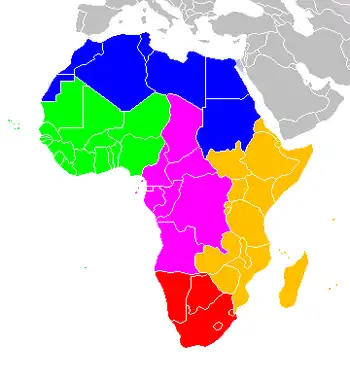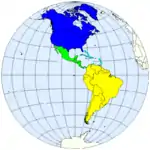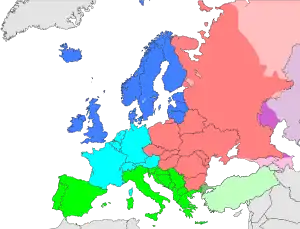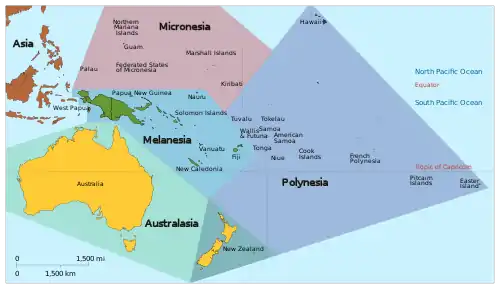United Nations geoscheme
The United Nations geoscheme is a system which divides 249 countries and territories in the world into six regional, 17 subregional, and nine intermediate regional groups. It was devised by the United Nations Statistics Division (UNSD) based on the M49 coding classification.[1] The creators note that "the assignment of countries or areas to specific groupings is for statistical convenience and does not imply any assumption regarding political or other affiliation of countries or territories".[1]

Usage
The schema was created for statistical analysis and consists of macro-geographical regions arranged to the extent possible according to continents.[1] Within each region, smaller geographical sub-regions and sometimes intermediate regions contain countries. Countries are also grouped nongeographically into selected economic and other sets.
Antarctica is the only geographical region which does not comprise any sub-regions or country-level areas.
The UNSD geoscheme does not set a standard for the entire United Nations System, and it often differs from geographical definitions used by the autonomous United Nations specialized agencies for their own organizational convenience. For instance, the UNSD includes Cyprus and Georgia in Western Asia, yet the United Nations Industrial Development Organization and UNESCO include them in Europe.[2][3] This "statistical" definition also differs from United Nations Regional Groups
Alternative groupings
Other alternative groupings include the World Bank regional classification,[4] CIA World Factbook regions and Internet Corporation for Assigned Names and Numbers Geographic Regions.[5][6][7]
Americas
† The Caribbean, Central America, and Northern America together form the geographical continent of North America.[1]
Maps
See also
References
- "UNSD — Methodology". unstats.un.org. Retrieved 2019-06-17.
- United Nations Industrial Organisation p. 14
- UNESCO, Europe and North America, Retrieved: 10 May 2016
- Katrin Elborgh-Woytek; Monique Newiak; Kalpana Kochhar; Stefania Fabrizio; Kangni Kpodar; Philippe Wingender; Benedict J. Clements; Gerd Schwartz (20 September 2013). Women, Work, and the Economy:Macroeconomic Gains from Gender Equity. International Monetary Fund. p. 7. ISBN 978-1-4843-9529-5.
Country groups are based on UN geoscheme and World Bank regional classification
- ICANN Geographic Regions
- ICANN Geographical Regions, Final Report by the ccNSO Regions Working Group, For Submission to the ICANN Board, 24 September 2007
- "World Bank Country and Lending Groups", the World Bank




